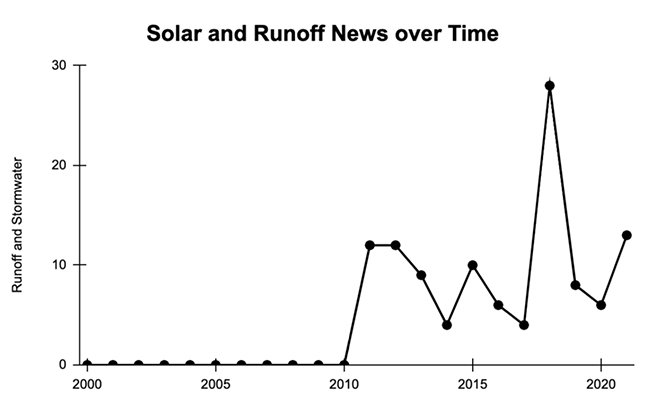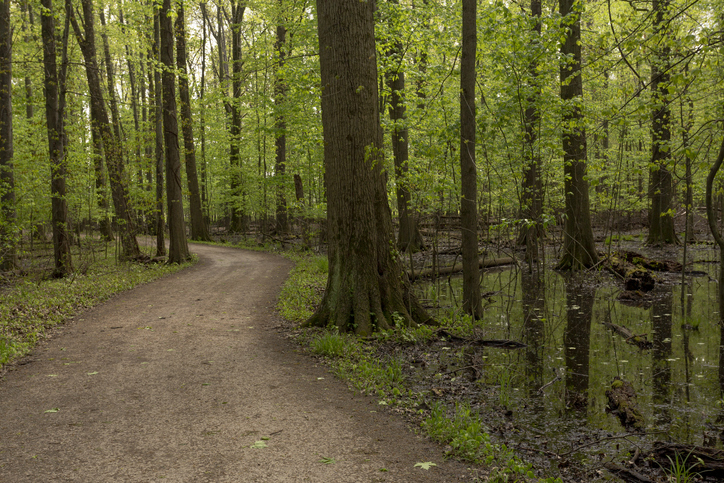Hydrologic Impacts of Large-Scale Ground-Mounted Solar Require More Research
February 2, 2022
The replacement of carbon-based electricity production with renewables will cause major changes to our regional landscape as solar production grows to provide more energy to power grids. This necessary shift will come with some undesired effects, and many residents in our region are concerned about what changes to expect to local hydrology as forests and fields are increasingly converted to commercial solar arrays.
With funding from University of Massachusetts Amherst, we investigated the scale of community concern regarding changes to water quality and quantity as a result of large-scale commercial solar development. We queried a database of Massachusetts newspapers for the keywords “solar” and “runoff” or “stormwater.” A clear consensus emerged: renewable energy is wanted, but people are concerned about many issues regarding water quality and quantity.
Prior to 2011, there were few recorded concerns about ground-mounted solar’s impact on the regional landscape. However, since then, community apprehension about these potential hydrological changes has been documented in at least 11 out of the 14 counties across Massachusetts. The year 2018 saw a relatively large amount of worry surrounding proposed commercial solar installations, with residents often citing concerns about the potential for increased runoff as the reason for their hesitancy about a project.
Lack of scientific publications on potential hydrogeological implications — which could include changes to runoff patterns, stormwater drainage, and retention pond capacity on newly sited solar installations — have left professional engineering consultants unsure of how a project that is being advertised as environmentally conscious may have externalities related to clean water. Especially important to keep in mind is that as a result of rising temperatures, rain events are predicted to become more common in coming years, potentially posing an additional risk to both the natural and anthropogenic systems designed to handle precipitation.
The need for further research on the impact of commercial, ground-mounted solar on stormwater drainage systems and runoff is exemplified by the community concerns that have been raised. Many hydrologists themselves are unsure of what changes to expect to landscapes during and after solar installations of this magnitude.
Stephen Garabedian, a professional hydrogeologist based in Belchertown, Mass., has said he is “very concerned” about the amount of runoff from a proposed solar installation upstream from his home. Garabedian noted he did not believe the ground-mounted array was designed to properly handle increased potential runoff, despite the company contracted to install the site’s claims that they were “maintaining all natural drainage patterns.”
Amherst’s wetlands administrator, Erin Jacque, who is also the Conservation Commission liaison for the town, said “the biggest recurring concern from community members is related to conversion from forest to solar field. Folks want to know what happens to the water.”
Jacque described instances of expanding wetland extent post-clearance due to added runoff, which could pose flooding hazards for abutters. Solar design often happens before site visits can occur, and as a result, developers do not have good knowledge of site conditions such as soil properties or depth to water table.

In addition to these hydrogeologic concerns, apprehension about the carbon footprint of commercial-scale solar has emerged alongside the growing solar industry. A 2019 story by Scott Merzbach in the Daily Hampshire Gazette headlined When the cost of solar is forestland and farms, discusses instances of local concern regarding the clear-cutting of trees for ground-mounted solar. Merzbach noted the value of solar installations that minimize disruptions to local land, such as those that accommodate panels alongside crops like corn and hay.
Even without understanding the effects that solar installations can have on runoff and water quality, clearing land in the name of sustainability is still controversial. Siting solar panels on agricultural land can reduce the resilience of regional food systems, requiring sourcing more food from outside the region and increasing the carbon emissions that accompany food transport.
Forests that are removed to make room for large- or medium-scale solar installations are effective at naturally reducing levels of atmospheric CO2 through carbon sequestration. Assessments of carbon sequestration’s role in mitigating global warming, such as the International Panel on Climate Change’s Sixth Assessment Report, stress the potential role that forests may be able to play in keeping global average temperature rise as close to 1.5 degrees Celsius as possible.
As for the impact ground-mounted solar has on water quality, it’s not an issue that has received much attention. In a 2015 publication titled Questions & Answers: Ground-Mounted Solar Photovoltaic Systems, which was produced by the Massachusetts Department of Energy Resources, the Massachusetts Department of Environmental Protection (MassDEP) and the Massachusetts Clean Energy Center, only one of 24 pages is dedicated to “water-related impacts.”
Within this section, the last before the appendix, there is discussion around the legality of installing commercial, ground-mounted solar in wetland areas, which is discouraged due to noncompliance with performance standards in the state’s Wetlands Protection Act. MassDEP, however, has determined that the “installation of solar arrays can be compatible with the operation and protection of public drinking water systems,” and that installing solar arrays on undeveloped land can actually preserve the quality of the land surface “provided the project design … avoids concentrated runoff.”
While commercial-scale, ground-mounted solar continues to be installed as a method of reducing carbon emissions, the data supporting its minimally impactful presence is lacking. More research on the role that solar arrays can play in redirecting stormwater runoff and disrupting stormwater management systems is needed before ground-mounted solar can truly be marketed as an effective mitigation strategy for global climate change.
Research that focuses on the effects of commercial solar on various landscapes, such as hilly or flat, would be particularly beneficial in helping local governments and contracted companies to decide where it is best to site an array. Without a better understanding of how land use change can impact hydrogeologic processes, community apprehension about solar will continue to be met with vagueness and uncertainty.
Bridget Beaudoin is a third-year undergraduate at the University of Massachusetts Amherst majoring in environmental science. Brian Yellen is a research professor in geosciences at UMass Amherst.



